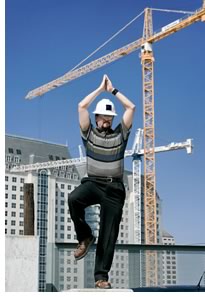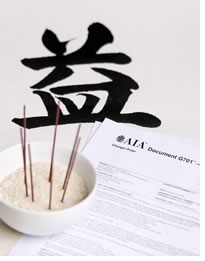

10/2005
by James B. Atkins, FAIA, and Grant A. Simpson, FAIA
In
activity there should be calmness, and in calmness there should be activity.
—Daisetsu Suzuki
 If your preparation has been thorough, you can more effectively go about
your administrative tasks. The actions that you take during the construction
phase can greatly affect your level of risk and determine if the project
will go smoothly. Here are some guidelines.
If your preparation has been thorough, you can more effectively go about
your administrative tasks. The actions that you take during the construction
phase can greatly affect your level of risk and determine if the project
will go smoothly. Here are some guidelines.
Conduct conferences and project meetings: The most significant planning event of the construction phase is the pre-construction conference. A suggested agenda is provided on page 610 of The Architect’s Handbook of Professional Practice, 13th edition. Send the agenda out in advance and conduct the meeting. The detailed meeting notes that are published from the meeting can serve as a “procedures manual” for the project. Conduct scheduled project meetings during the course of construction. Regular, structured meetings can facilitate the efficient exchange of communication and required documents.
Contractor deliverables: Enforce the receipt of contractor-provided documents and information as required in the contract documents. These items were addressed in August’s article, “Drawing the Line,” and they are essential for the Contractor’s Plan for the Work. They include the following items normally required by the contract documents:
• An acceptable submittal schedule
• Specified submittals—no more, no less
• Pre-installation conferences
• Coordination drawings
• Clarification sketches
• Mock-ups
• Contractor marked-up drawings
• Stored material back-up
• Construction schedule and updates.
Effective documentation: The actions that you take on a project during construction may not help you if they are not adequately documented. Oral communications aren’t worth the paper they’re written on, and people sometimes suffer from selective amnesia when it is convenient. We are not aware of any lawsuit that was ever successfully prosecuted against an architect for having prepared too much documentation. Documentation activities can include:
• Field observation reports
• Project meeting reports
• Document control log entries
• Written memoranda
• Entries in your journal
• Written response to any accusatory correspondence
• Transmittal letters with outgoing documents
• Received stamps on incoming documents
• RFIs sent to the contractor and tracked.
Some architects may be unfamiliar with the process of the architect sending a Request for Information (RFI) to the contractor. The RFI is a method of documenting a request for an answer to a question or for information. AIA form G728-2004, Request for Information, is available for this purpose. The architect can use RFIs to document a request for information such as the submittal schedule, meeting notes from pre-installation conferences, or submittals that are past due according to the submittal schedule.
(For additional information concerning developing good documentation habits, you may wish to refer to the third article in this series, “To Document or Not to Document.” It is available for AIA members on AIA.org at the Risk Management Resource Center.)
 Maintain good relationships. The way in which the architect and contractor
interact during construction can be affected by the type of contract,
previous work together, the owner’s behavior, the contractor’s
business priorities, or the architect’s attitude. But regardless
of the issues, it is always advantageous to maintain an amicable relationship.
Maintain good relationships. The way in which the architect and contractor
interact during construction can be affected by the type of contract,
previous work together, the owner’s behavior, the contractor’s
business priorities, or the architect’s attitude. But regardless
of the issues, it is always advantageous to maintain an amicable relationship.
If the contract is hard bid, there is a greater likelihood that the contractor will more intensively scrutinize your document content than if it is a negotiated cost-plus contract. If you subcontract to the contractor in a contractor-led design-build scenario, your requirements for evaluating work conformance may be reduced, or may not be required.
The owner’s behavior can greatly affect the way that the team interacts. One-time owners less familiar with the construction process sometimes introduce friction into the team relationship because their expectations are not realistic. Developers, on the other hand, who build repeatedly, have a greater understanding of the sometimes bumpy process, and their expectations are usually more reasonable.
The construction phase involves pressures induced by time and money, and administering the construction contract while maintaining your composure can be challenging. Always maintain a professional attitude. Try to look at problem issues from both sides. A calm approach when dealing with tense situations is advantageous.
When tense situations arise, you should endeavor to minimize emotions to the greatest extent possible. It has been suggested that when in a heated exchange where your counterpart is yelling or speaking loudly, you should respond in a low voice, forcing them to lower their voice to hear you. Effective project management goes well beyond merely conforming to the contract and meeting deadlines. Problems can be solved and decisions made much more easily and in less time when the project team interacts with respect and civility.
Being there
Put off for one day and 10 days will pass.
—Korean Proverb
 The essence of proactive construction contract administration is being
there. This involves being available to the owner and contractor, responding
quickly to any issue or need, constantly communicating with team members,
and running at the problems that arise. Remember that during construction,
the owner’s money is usually being spent at a high burn rate, and
time spent addressing problems can affect the rate. Regardless of how
good your design is or how pretty your drawings are, the owner will likely
remember more about her or his unpleasant experiences during construction.
We have always said that construction administration is the service that
leaves the “last taste in the owner’s mouth,” and the
positive effect that CA can have on repeat work and giving favorable
references to future clients is simple math.
The essence of proactive construction contract administration is being
there. This involves being available to the owner and contractor, responding
quickly to any issue or need, constantly communicating with team members,
and running at the problems that arise. Remember that during construction,
the owner’s money is usually being spent at a high burn rate, and
time spent addressing problems can affect the rate. Regardless of how
good your design is or how pretty your drawings are, the owner will likely
remember more about her or his unpleasant experiences during construction.
We have always said that construction administration is the service that
leaves the “last taste in the owner’s mouth,” and the
positive effect that CA can have on repeat work and giving favorable
references to future clients is simple math.
A good way always to be available these days is to give out your cell phone number and carry a wireless communications device. If your clients know they can readily reach you at any time, you have established a link with them on a very personal level. If there is a problem on the project, you need to know about it as early as possible.
Most clients spend the construction phase worrying about time and money. It follows that if you do not want them to think that you are costing them money, you should respond as quickly as you reasonably can to all critical issues. It’s a good idea to establish a protocol at the office so that, if you are unavailable, someone can cover for you and respond rapidly and appropriately. A quick-response program also includes the timely issuance of reports and other important project documents.
Constant communications means exactly that. Just because there are no emergencies is no reason not to touch base regularly. You may not have to worry about frequent communications with the contractor, because they will likely be calling you, but you should make a point to stay in close touch with the client. Remember that last taste?
If it is taking an extended amount of time to research a problem and develop a response, an occasional message to the client reporting your progress will put them at ease and demonstrate that you are working on the problem. Clients usually assume that no communications means inactivity and inaction.
Problem Seeking
You must take care not to make mistakes. But when they happen, learn
from them. Use your mistakes as a springboard into new areas of discovery;
accidents can hold the key to innovation.
—P. T. Sudo
 Effective problem solving should go beyond the reactive resolution of
problems as they arise. It should include a constant scrutiny of the
contract documents and the work as it is being constructed. This should
be a mindset more than a planned activity. It could involve such things
as a follow-up visit to check on a problem issue to determine if all
is going well, or a phone call to the contractor after a sensitive RFI
has been answered to be sure that the response is understood.
Effective problem solving should go beyond the reactive resolution of
problems as they arise. It should include a constant scrutiny of the
contract documents and the work as it is being constructed. This should
be a mindset more than a planned activity. It could involve such things
as a follow-up visit to check on a problem issue to determine if all
is going well, or a phone call to the contractor after a sensitive RFI
has been answered to be sure that the response is understood.
It is helpful to develop habits that complement and support your problem-seeking activities. If you carry a tape recorder with you on the job site, you can give yourself prompts on site conditions and details to recheck when you get back to your office. You could add “potential challenges” to your regular project meeting agenda to invite early detection of problematic issues. Contractors who prepare an effective Plan for the Work, as required by their contract, will usually pinpoint challenges and complications well in advance.
Another preventive activity is to cross-check your projects. When there are multiple projects in an office, a problem in the documents encountered on one project may be systemic to the internal document development process. Some firms have construction administration departments where the CAs can compare notes and openly discuss issues. Firms that are not departmentalized can hold scheduled meetings to discuss document performance issues. The August article in this series, “Your Grandfather’s Working Drawings,” addressed the inherent challenges in adapting CAD library details to fit unique project conditions.
Remember, time is money during the construction phase, and problems, if detected early enough, can often be resolved before related construction work is put in place. The problem-seeking mindset allows for more opportunities to discover and resolve issues within a more efficient time frame.
Conclusion
Zen is not some kind of excitement, but concentration on our usual everyday
routine.
—Shunryu Suzuki
Most young architects enter the job market generally unprepared for construction-phase services, and most firms struggle with providing appropriate construction services with the goal of financially breaking even. Add to this challenge the task of avoiding a claim after the project is completed.
Let’s face it: Construction administration is neither easy nor glamorous. We display photographs and renderings of our projects around our office to impress our clients, but we do not display change orders and field observation reports. The media will sometimes credit the building designer, but they don’t seem as interested in the architect of record. It is not common to see a major box office star playing the part of a construction administrator, adorned with tape measure, mirror, and boots. Paul Newman’s architect character Doug Roberts, in the movie The Towering Inferno, was represented to have weak construction administration skills as he discovered design and construction defects in the building during the fire.
Yet we must provide adequate services during construction if we wish to avoid claims and we want the owner to have fond memories of our overall performance. We must stay on top of the game if we expect to survive the value analysis and substitution process and develop a reasonable comfort level for work conformance. We cannot afford to be passive and let things fall as they may.
The best recourse is to run at and embrace construction administration instead of avoiding it. The better we become at it, the more successful we will be in our practice. We must keep our eyes open and proactively administer construction-phase services. Availability, quick responses, good documentation, and informed decisions will hopefully leave a good taste in the owner’s mouth, thus bringing good references and repeat business.
Yet construction administration need not be tenuous and stressful. It is best to be calm and approach each challenge with cool professionalism. The young Caine in Kung Fu warned, “If one’s words are not better than silence, one should keep silent.” And don’t point out blame too quickly, lest you find yourself staring at your own index finger. Attempt to develop an intuitive approach to issues and conditions, remaining sensitive to potential problems and the concerns of others. Don’t be overly defensive, as it will cloud your understanding of and ability to resolve problems.
So now, Grasshopper, put on your hard hat, protective goggles, work boots, and safety vest and, as you go about your construction administration duties, remember, be careful out there . . .
Copyright 2005 The American Institute of Architects.
All rights reserved. Home Page ![]()
![]()
 |
||
This
article is a continuation of last week’s Part 1, to read
it, go to that article. This series will continue next month in AIArchitect when the subject will be “Architect: Master and Commander—The Architect’s Authority” This article will examine the architect’s duties both as a decision maker and as a recommending consultant and the critical importance of being able to tell the difference. For more information on Shaolin Kung Fu and Zen, go to the Shaolin
Kung Fu, Qigong and Zen home page. For more information on the 1970s TV series, Kung
Fu, go to the
show’s episode guide. If you would like to ask Jim and Grant a risk- or project-management question or request them to address a particular topic, contact the AIA General Counsel’s office. James B. Atkins, FAIA, is a principal with HKS Architects. He serves on the AIA Documents Committee and the AIA Risk Management Committee. Mr. Atkins is an accomplished construction administrator. Grant A. Simpson, FAIA, manages project delivery for RTKL Associates. He serves on the AIA's Practice Management Advisory Group. This article is intended for general information purposes only and does not constitute legal advice. The reader should consult with legal counsel to determine how laws, suggestions and illustrations apply to specific situations.
|
||